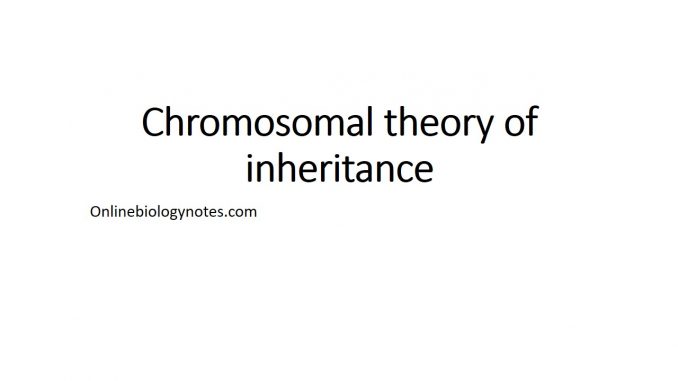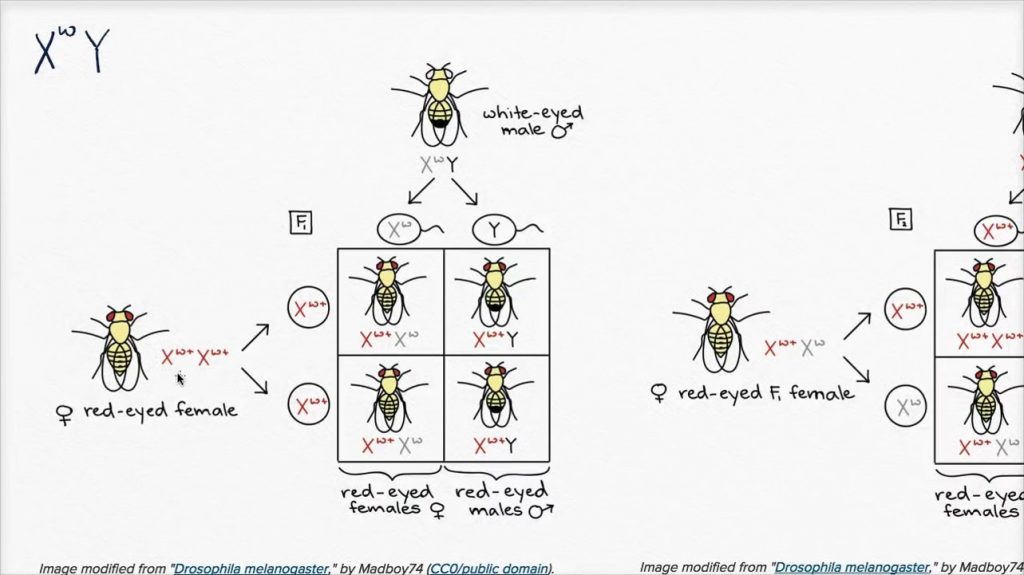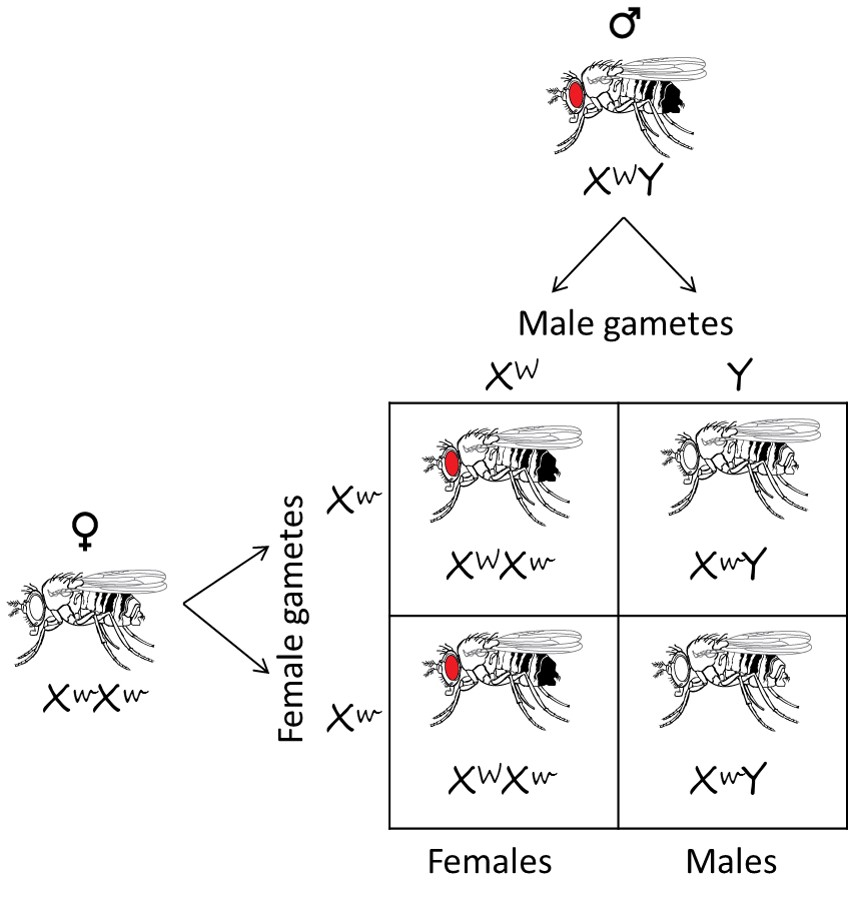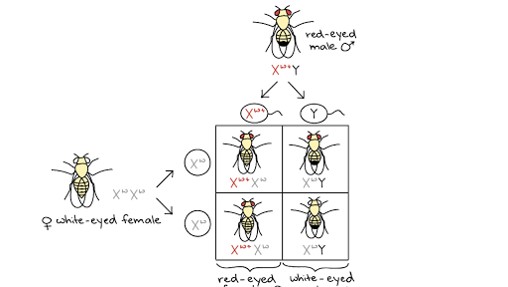
Chromosomal theory of inheritance
- In 1902 and 1903, Sutton and Boveri published independent papers proposing the chromosome theory of inheritance.
- According to Chromosomal theory of inheritance, chromosome is the genetic material responsible for Mendelian inheritance. At that time, Mendel knew nothing of the chromosomes and meiosis.
- In order to explain the law of independent assortment Sutton and Boveri suggested that different genes were in different chromosomes completely independent of one another.
- This theory states that individual genes are found at specific locations on particular chromosomes, and that the behavior of chromosomes during meiosis can explain why genes are inherited according to Mendel’s laws.
- Thus, similarity between the Mendelian factors and chromosomes became apparent.
Chromosomal Theory of Inheritance supports Mendel’s law
- In somatic cell, the chromosome or gene occurs in pairs because one chromosome is from father and other from mother to form homologous pair.
- During meiosis or gametogenesis, homologous chromosome pairs segregates independent of other chromosome pairs. Thus, a gamete contains only one particular type of chromosome ie. a gamete contains only one of two allele of particular trait.
- The sorting of chromosomes from each homologous pair into pre-gametes appears to be random and it is similar to Mendel’s law of independent assortment
- Similarly, Chromosome are transferred from one generation to another. And the number of chromosome is fixed in each organism.
- Even though male and female gametes differ in size and morphology, they have the same number of chromosomes, suggesting equal genetic contributions from each parent.
- The gametes combine during fertilization to produce offspring with the same number of chromosome number as their parents
Morgan’s experiments on Dorsophila melanogaster to explain chromosomal theory of inheritance
- In 1910, Thomas Hunt Morgan performed experiment on Drosophila melanogaster
- Dorsophila melanogaster is commonly known as a fruit fly. It has only four pair of chromosomes (three pair of autosomes and a pair of sex chromosome). At the time of experiment, it was knew that X and Y chromosomes are associated with gender.
I. Cross between Red eyed female (Xw+ Xw+) and white eyed male (Xw Y)

- In Drosophila, normal flies have red eyes and mutated flies have white eyes.
- In the experiment, normal flies with red eyes and mutated flies with white eyes are crossed and offspring are observed.
- Dominant allele: Red eye color.
- Recessive allele (mutated): white eye
- When a red eyed female (Xw+ Xw+) and white eyed male (Xw Y) were mated, all the progeny in F1 generation had red eyes
- According to Dominant and recessive inheritance pattern, this result makes perfect sense.
II. Reciprocal cross- red eyed male (Xw+ Y) and white eyed female (Xw Xw)

- A surprising result was obtained when the reciprocal cross was performed by mating white eyed females to red eyed males.
- In F1 generation, instead of obtaining all the progeny with red eye, the result showed that all the progeny females had red eyes and all the progeny males had white eyes.
- This result shows traits for gender and eye color are linked, which is not accordance with Mendel’s law of independent assortment.
- This result can be explained only if gene for color of eye is present on X chromosome and are linked.
- Thus, this experiment on eye color of Drosophila supports the chromosome theory of inheritance. Now, all the patterns of inheritance observed by Mendel, including the principle of segregation and the principle of independent assortment can be explained by the behavior of chromosomes during meiosis and chromosome theory of inheritance.
Note: Males are known as Hemizygous because they have only one allele for any X-linked traits. Therefore, a male with the recessive allele will always show the recessive trait, because he only has one copy of the allele.
- We know, most genes are located on autosomes. This experiment of Morgan establish that gene for eye color in Drosophila is on X-chromosome and it is the first X-linked trait to be identified.
NON disjunction as proof of chromosomal theory of Inheritance:
- Morgan showed that a gene for eye color was on the X chromosome of Drosophila
- One of his students, C. B. Bridges, who secured proof of the chromosome theory by showing that exceptions to the rules of inheritance could also be explained by chromosome behavior.
- Bridges performed one of Morgan’s experiments on a larger scale.
- In his experiment, white-eyed female Drosophila (Xw Xw) crossed with red-eyed males (Xw+ Y) and examined many F1 progeny.
- In F1 generation, following results are obtained;
- Almost all of the F1 progeny flies are either red eyed females or white eyed males which are normal
- But few flies such as white-eyed females and red-eyed males are also obtained which are exceptional.
- When he tried to crossed red eyed F1 progeny males with normal white eyed females, it was found that all the F1 progeny red eyed males were sterile.
- However, the F1 progeny white eyed females were fertile. When these white eyed females were crossed with normal red eyed males, many F2 progeny were obtained as white eyed females and red eyed males.
- It seems, the exceptional F1 progeny females produced large number of exceptional progeny in successive generation.

Explanation of result:
- Bridges explained these results by proposing that the exceptional F1 flies were the result of abnormal X chromosome behavior during meiosis in the females of the P generation.
- Normally the X chromosome in females separates or disjoin during gametogenesis but Occasionally, they might fail to separate, producing an egg with two X chromosomes (diplo-X) or an egg with no X chromosome at all (nullo-X) known as NONDISJUNCTION
- Fertilization of such abnormal eggs by normal sperm would produce zygotes with an abnormal number of sex chromosomes.
- If an egg with two X chromosomes (XwXw) is fertilized by normal Y chromosome of sperm (Y)- the zygote will be XwXwY. Since each of the X chromosomes in this zygote carries a mutant Xw allele, the resulting fly will have white eyes.
- If an egg without an X chromosome (O) is fertilized by an X-bearing sperm (Xw+), the zygote will be Xw+ O. (O- denotes absence of a chromosome.) Because the single Xw+ in this zygote carries mutant Xw+ allele, the zygote will develop into a red-eyed fly
- It is inferred that XXY flies were female and that XO flies were male. The exceptional F1 white-eyed females that were observed were therefore XwXwY, and the exceptional F1 red-eyed males were Xw+O.
- Bridges confirmed the chromosome constitutions of these exceptional flies by direct cytological observation.
- Because the XO animals were male, Bridges concluded that in Drosophila the Y chromosome has nothing to do with the determination of the sexual phenotype. However, because the XO males were always sterile, he realized that this chromosome must be important for male sexual function.
- Bridges called the abnomaly nondisjunction because it involved a failure of the chromosomes to disjoin during meiotic divisions.
Causes of nondisjunction:
- faulty chromosome movement
- imprecise or incomplete homologous pairing,
- centromere malfunction.
- From Bridges experiment, in F2 generation, exceptional XwXwY females produces high frequency of exceptional progeny, it means, the nondisjunction of sex chromosome goes on disjunction.
- XXY Sex chromosomes can disjoin in different ways:
- Either X chromosomes can disjoin from each other form to form: X and XY
- OR X chromosome can disjoin from the Y to form: XX and Y: In the latter case, a diplo- or nullo-X egg is produced because the X that does not disjoin from the Y is free to move to either pole during the first meiotic division. When fertilized by normal sperm, these abnormal eggs will produce exceptional zygotes.
- These early studies with Drosophila—primarily the work of Morgan and Bridges greatly strengthened the view that all genes were located on chromosomes. Thus chromosome are the genetic material for inheritance.
